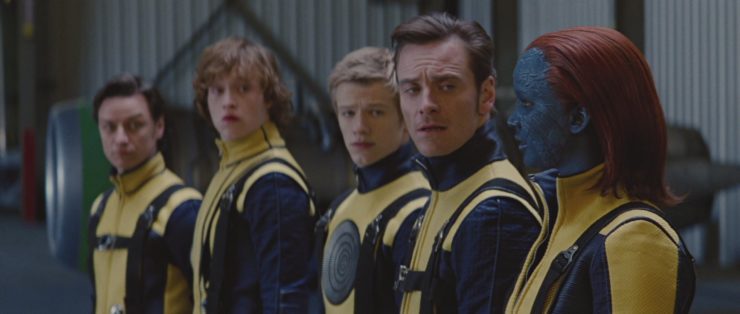In one year, the Uncanny X-Men creative team of Chris Claremont and Dave Cockrum managed two retcons of the character of Magneto that changed everything we knew about the character—the year in question being 1982, two decades after the character was introduced in Uncanny X-Men #1 by Stan Lee and Jack Kirby.
The first was to establish in issue #150 that Magneto was a survivor of the Nazi concentration camps during World War II. Eleven issues later, a flashback issue showed that Magneto and Professor Charles Xavier actually met for the first time before Xavier founded the X-Men, and were dear friends before becoming arch-enemies. When the X-Men were adapted to the screen in 2000, that backstory was the spine of the film, and the plan after X-Men Origins: Wolverine was to do a similar movie for Magneto.
That didn’t quite happen, and we got X-Men: First Class instead…
Fox had been considering doing a “young X-Men” movie going all the way back to the production of X2. When it was decided to do “origins” movies, in addition to one for Wolverine, Sheldon Turner wrote up a Magneto film that would focus on his time in Auschwitz. However, the lukewarm response to Wolverine’s film, as well as producer Simon Kinberg’s desire to do something along the lines of Marvel’s X-Men: First Class comics series, led to doing an origin story instead. But where the comic provided untold adventures of the original team of X-Men from the 1960s, Kinberg wanted to do something different with the movie, utilizing new characters. However, the movie was to take place in the 1960s, in the shadow of the Cuban Missile Crisis.
Bryan Singer, having crashed and burned with Superman Returns, returned to the X-franchise and did a treatment of his own for a First Class movie, but he wound up going off to direct Jack the Giant Killer instead, though he remained as a producer of this film. Genre veterans Ashley Edward Miller and Zack Stentz (who are, full disclosure, friends of your humble rewatcher) were brought in to create a script from both Turner’s and Singer’s treatments, one that also in essence adapted the above-referenced first meeting of Xavier and Magneto in Uncanny X-Men #161.
Buy the Book
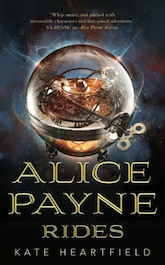

Alice Payne Rides
Matthew Vaughn, who’d been approached to direct X-Men: The Last Stand, but backed out, was approached to direct based on his work on Kick-Ass, and he accepted, doing a new draft of the script with his regular collaborator Jane Goldman.
The film combines younger versions of established characters with ones that hadn’t yet been seen on screen. James McAvoy and Michael Fassbender headline as the younger Xavier and Magneto, respectively, while Jennifer Lawrence, Rose Byrne, and Nicholas Hoult play younger versions of Mystique, Moira MacTaggart, and Hank McCoy, respectively. In addition, this film introduces the film version of longtime X-foe, the Hellfire Club. We get Sebastian Shaw (Kevin Bacon), Emma Frost (January Jones), and Riptide (Álex González), as well as Azazel (Jason Flemyng), who in the comics is Nightcrawler’s father, but here is a member of the Club as well. Other comics characters include Cyclops’s brother Alex Summers, a.k.a. Havok, played by MacGyver himself, Lucas Till; Caleb Landry Jones as Sean Cassidy, a.k.a. Banshee; Armando Muñoz, a.k.a. Darwin, played by Edi Gathegi; and Zoë Kravitz as Angel Salvadore, a.k.a. Tempest. In addition, there are cameos by Rebecca Romijn as one of Mystique’s disguises (an amusing in-joke) and Hugh Jackman as Wolverine, the only two actors from the previous set of X-films to appear. We also get Ray Wise, Rade Sherbedgia, Matt Craven, and Michael Ironside in small roles.
Just as Stewart and McKellen anchored the first three films, McAvoy and Fassbender will anchor the series moving forward, starring alongside the former two in the next film: the time-travel adventure Days of Future Past, which takes place primarily in the 1970s. After that, the series jumps to the 1980s for Apocalypse, and the upcoming Dark Phoenix is to be set in the 1990s.
“We can start something incredible, Erik—we can help them!”
X-Men: First Class
Written by Sheldon Turner and Bryan Singer and Ashley Edward Miller & Zack Stentz and Jane Goldman & Matthew Vaughn
Directed by Matthew Vaughn
Produced by Lauren Shuler Donner and Bryan Singer and Simon Kinberg and Gregory Goodman
Original release date: June 3, 2011
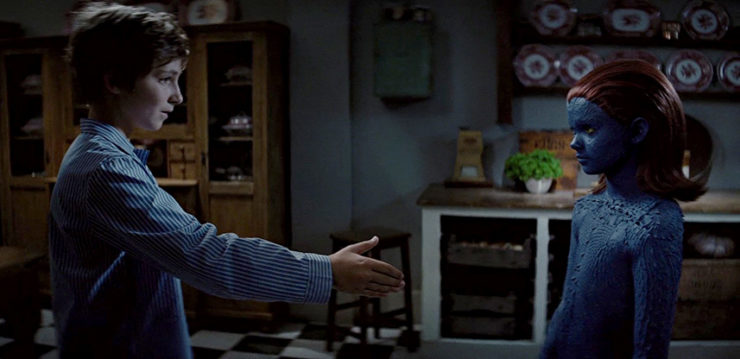
We open with a re-do of the opening of X-Men, with young Erik Lehnsherr in Auschwitz in 1944, but this time we see that his bending of the gate after being separated from his mother is observed by Klaus Schmidt, who wishes to use Lehnsherr’s abilities for himself. He tries to get the boy to use his magnetic powers, but he can only do it when angry. So he shoots Lehnsherr’s mother in front of him, which does the trick.
Also in 1944, young Charles Xavier detects an intruder in the kitchen with his telepathy. It looks like his mother, but acts nothing like her, nor do her thoughts match those of his mother. She reveals herself to be a blue-skinned girl named Raven who can change her appearance. She broke into the mansion to steal food, but Xavier offers her a place to stay.
In 1962, Lehnsherr is trying to locate Schmidt. He intimidates the head of the illegal bank where Schmidt has been keeping the gold bars he pressed from the fillings of his prisoners into giving up Schmidt’s location.
In Las Vegas, we find out that Schmidt is now calling himself Sebastian Shaw, and he runs the Hellfire Club, which is under surveillance by a CIA team that includes Moira MacTaggart. She infiltrates the club to find that Shaw has suborned U.S. Army Colonel Hendry, and also has three people working for him, one of whom can read thoughts and change herself into a diamond form (Emma Frost), another of whom has red skin and can teleport (Azazel), and the third of whom can create mini-tornadoes (Janos Quested). But when MacTaggart reports this to her CIA superiors, they assume she imagined it, as she’s a woman, and women aren’t suited for field work. (Ah, 1962…)
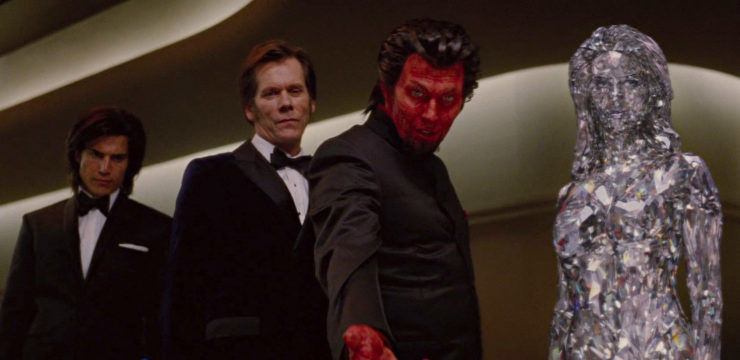
Shaw mentioned that Frost, Quested, and Azazel are genetic mutations, so MacTaggart goes to an expert on genetic mutation: Xavier, who just received his doctorate from Oxford. Raven is with him there, working as a waitress. Xavier sees the images of Frost and Azazel in MacTaggart’s mind and agrees that something needs to be done.
Hendry has, on Shaw’s order, recommended that the U.S. put missiles in Turkey, even though that is provocative to the Soviet Union. When he returns to get paid by Shaw, he holds up a grenade, as he doesn’t trust Shaw’s people not to use their powers on him. But it turns out that Shaw is also a mutant—he can absorb energy and redirect it, and he absorbs the power of the grenade explosion and turns it back on Hendry, killing him.
MacTaggart brings Xavier and Raven to the CIA. They don’t believe a word Xavier says, nor do they believe he’s really a telepath, assuming his inside knowledge to be a parlor trick or the work of a spy, but then Raven changes shape right in front of them and they start to believe.
One agent agrees to take them to his facility, called Division X. But first they go after Shaw on his yacht. Unfortunately, Frost is able to block Xavier’s telepathic probes. However, Lehnsherr has also tracked Shaw to the yacht and uses his magnetic powers to attack the boat. Lehnsherr is almost killed, and Shaw and company get away, but Xavier saves Lehnsherr’s life and brings him back to Division X.
At Division X, they meet Hank McCoy, a scientist who also turns out to be a mutant, with enhanced agility and prehensile feet. McCoy has built a telepathic amplifier that Xavier could use to detect mutants. Xavier uses Cerebro to track down mutants and he and Lehnsherr go to recruit them for Division X. Their recruits include Raven; McCoy; Armando Muñoz, who can physically adapt to any situation; Alex Summers, who can shoot uncontrolled beams of force; Sean Cassidy, whose voice can achieve supersonic tones; and Angel Salvadore, whose dragon-wing tattoos on her back can become actual wings that enable her to fly, plus she can spit fire. (They try to recruit a Canadian mutant named Logan, who tells them to go fuck themselves.)
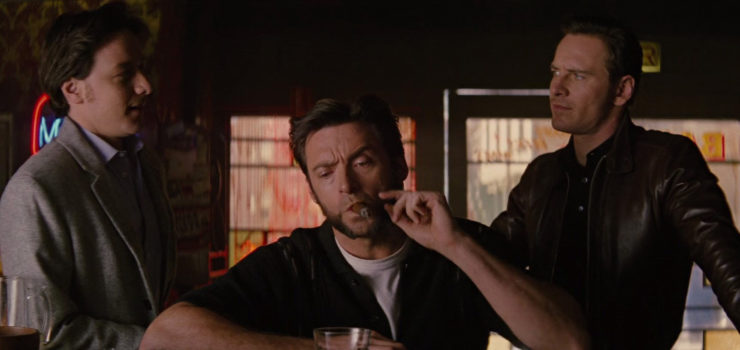
At Raven’s urging, they all take on codenames, since they’re CIA operatives now: Raven becomes Mystique, Muñoz becomes Darwin, Cassidy becomes Banshee, Summers becomes Havok. Neither Salvadore nor McCoy pick codenames, though everyone takes their turn showing off their powers. Mystique refers to Xavier as “Professor X” and Lehnsherr as “Magneto.”
Xavier and Lehnsherr head to a meeting that Shaw is having with a Soviet general—but Frost is the one who takes the meeting. Xavier and Lehnsherr are able to capture her. However, while that was happening, Shaw attacks Division X, killing everyone there except the mutants, to whom he offers a place in the Hellfire Club. Only Salvadore accepts; Darwin is killed trying to stop him.
The CIA discontinues Division X for obvious reasons. Xavier instead takes the remaining mutants to his Westchester mansion and begins training them in how to use their powers. According to what they’ve learned from Frost, Shaw is trying to start World War III by manipulating both the Soviets and Americans toward a tipping point, encouraging the Soviets to store missiles in Cuba. The resultant nuclear war will wipe out most of humanity and leave mutants to become ascendant as they’re destined to be.
As the Cuban Missile Crisis escalates, Xavier helps Lehnsherr learn to find a balance between serenity and anger (since his powers tend to work better when he’s angry), and McCoy develops a chestplate that focuses Havok’s powers. Xavier and Lehnsherr also teach Banshee how to fly.
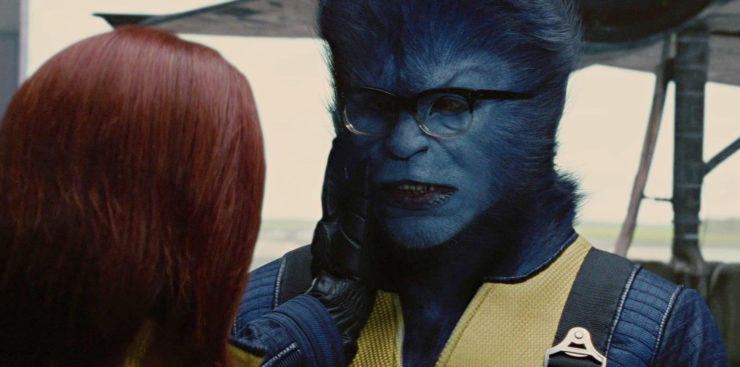
McCoy has developed a serum that will enable mutants to keep their powers but normalize their appearance. Mystique is interested at first, but Lehnsherr convinces her that she should take pride in her true appearance. McCoy injects himself, but the serum instead gives him blue fur and a leonine appearance. Havok gives him the nickname of “the Beast” at that point.
The “X-Men,” as MacTaggart later dubs them, fly to the blockade line in Cuba. Xavier uses his telepathy to get a Soviet submarine to fire on the ship carrying the missiles, destroying it. (Azazel had teleported on board and killed the crew, so they didn’t obey the orders to not cross the blockade.)
Lehnsherr raises Shaw’s submarine from undersea, after Banshee finds it with his own version of sonar. Havok and Banshee fight Salvadore and Quested. Shaw is wearing a specially designed helmet that renders him psychically invisible to Xavier. Lehnsherr finds him in his submarine’s engine room, and gets the helmet off him, at which point Xavier can take control of Shaw’s body.
Lehnsherr admits to agreeing with most of what Shaw says. But Shaw also killed Lehnsherr’s mother in front of him, which he cannot forgive. He kills Shaw by magnetically driving a coin through his head—which Xavier also feels through his telepathic contact with Shaw.
Taking Shaw’s helmet, Lehnsherr returns to the X-Men only to find that both the U.S. and U.S.S.R. forces are firing their missiles on the mutants. Lehnsherr takes possession of the missiles, though Xavier and the others are able to stop him from destroying the ships that fired them. (Xavier’s plea is that they’re just following orders, which is, like, the worst argument to use on someone who survived Nazi Germany…)
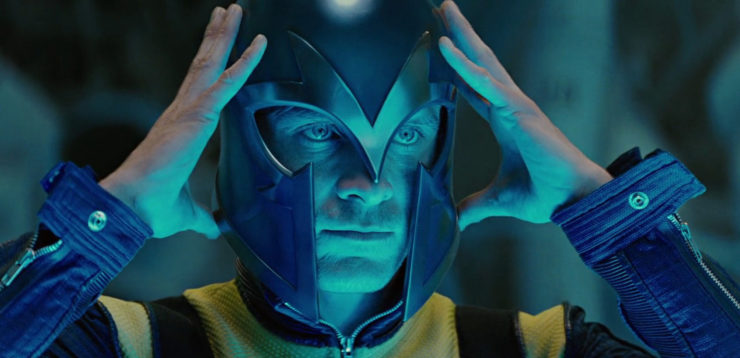
Lehnsherr declares that he will no longer follow Xavier, and invites any of the mutants present to come with him. MacTaggart tries shooting him, but he deflects the bullets, one of which goes into Xavier’s spine, paralyzing him. Mystique goes with Lehnsherr, with Xavier’s blessing, because he knows it’s what she wants. So do the three Hellfire Club members. Azazel teleports the newfound Brotherhood away.
Xavier, now wheelchair-bound, converts his family mansion to a School for Gifted Youngsters. He also erases MacTaggart’s memories of everything since Las Vegas (it’s unclear whether or not this is done with her consent) in order to protect the school’s secrecy, particularly from the CIA. Sadly, this makes MacTaggart’s position in the CIA even more tenuous.
Lehnsherr breaks Frost out of prison and recruits her for his new Brotherhood. He identifies himself for the first time as Magneto.
“We are children of the atom”
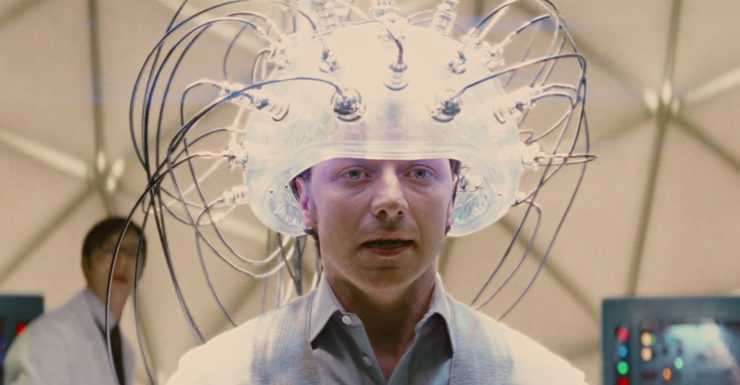
One of the things I liked about the X-movies is that they didn’t start from scratch. While X-Men was the first movie featuring Xavier and his students, it was also clear that they were pretty well established at that point, that Xavier has been rescuing and training and helping mutants for years. Given how many superhero movies of the 21st century have felt the need to start with the character’s origin (sometimes twice, viz. the Spider–movies), this is something of a relief. Over the course of that and several other movies, we saw that the X-Men have a history, from the recruitment of Jean Grey as a girl in the past and meeting former students like Hank McCoy in the present in The Last Stand to Xavier showing up at the end of X-Men Origins: Wolverine to take Scott Summers and the other victims of Stryker away to his school.
It is rare that comic book heroes actually have a history in real time in conjunction with their publication history. Even though Fantastic Four #1 came out in 1961, the FF weren’t actually formed fifty-seven years ago in-story. Comics have existed on a kind of sliding timescale, where the origin story was seven-to-ten years ago no matter when the current story comes out in relation to the first.
So it’s fascinating to watch First Class firmly establish that the X-Men in the Fox movies were actually formed around the time the comic book started. The movie primarily takes place in 1962 so it can be tied into the Cuban Missile Crisis, but that’s only one year prior to Uncanny X-Men #1’s publication. And it gives us the X-Men’s origin, not in their first film, but in their fifth.
The script and set design both do a decent job of setting things in the early 1960s. (The costuming and hairstyles, less so. Everybody’s wearing clothes and has hair that is more 2000s than 1960s.) In particular, the graphics are all 1960s era, the period sexism (particularly as seen in Matt Craven’s CIA boss’s attitude toward MacTaggart), and the tensions between the U.S. and the Soviet Union are all part of the tapestry of the story. But it’s also very much a spy thriller of the era, with super-powers added in, from the globe-hopping to the international intrigue. I particularly love that the war room is patterned, not so much after the actual war room in Washington, D.C. in 1962, but rather the one in Dr. Strangelove, or How I Learned to Stop Worrying and Love the Bomb. Having said that, it’s indicative of a lack of deep-dive research into the time period—it feels like they watched a few contemporary thrillers and left it at that. The dialogue never feels quite right (Xavier’s occasional use of “groovy” notwithstanding) for the era.
Matthew Vaughn and his fellow screenwriters didn’t concern themselves overmuch with perfect consistency with the prior films, prioritizing what makes this movie work over how the big pieces fit together. This can be frustrating, but to do otherwise would spoil the narrative of Xavier and Magneto’s split at the very end, as well as Magneto being the one responsible for Xavier’s paralysis (never mind that it contradicts the ambulatory Xavier seen in X-Men Origins: Wolverine and the opening of The Last Stand, and the latter with Magneto and Xavier still friends and allies at that point).
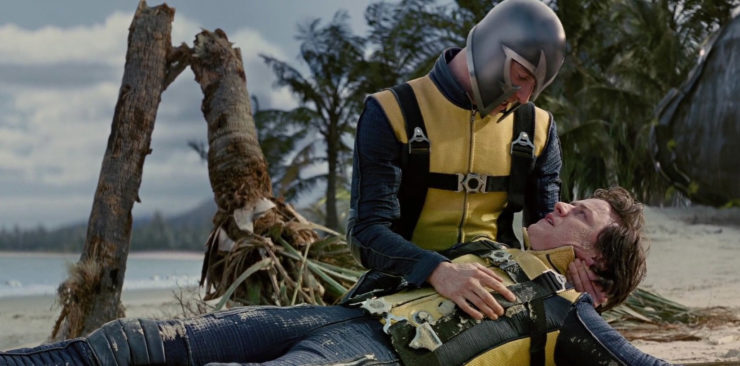
They do concern themselves with showing the evolution of its three main characters, however. This Xavier is young and rakish and still figuring out his place in the world. This Magneto is young and angry and completely focused on revenge against the person who killed his mother in front of him and tormented him and experimented on him as a child. And this Mystique is one who hides who she really is from the world, and we see the process that leads her to the poignant words she spoke to Nightcrawler in X2 about how they shouldn’t have to hide who they are.
It helps that there’s not a bad performance in the bunch. McAvoy, Fassbender, and Lawrence anchor a superlative cast that sells the characters beautifully. You believe that they’re going to age into Stewart, McKellen, and Romijn, but the performances aren’t imitative, either. Each actor makes the character his or her own.
Having said that, the movie is a bit overcrowded. Pyro changing loyalties in X2 was beautifully played and perfectly constructed. Salvadore’s similar change was not, and it’s mostly because the movie didn’t give us enough time to get to know her—or, really, anyone else beyond Xavier, Magneto, and Mystique. Darwin’s death is robbed of its poignancy by the character not having enough screen time. (Though Edi Gathegi, as usual, imbues him with tremendous charm.) Hoult doesn’t quite sell McCoy’s desire to normalize his feet in order to assimilate, especially since he’d already assimilated just fine before Xavier showed up. And none of Shaw’s Hellfire Club minions have any personality at all. Azazel is just a plot device in a devil suit, Frost—a fascinating and complex character in the comics—is just a plot device in white lingerie, and Riptide isn’t even really a plot device, he’s just kinda there.
Also the melding of the Sebastian Shaw of the comics with a Nazi officer who tormented Magneto as a boy is not nearly as smooth as the filmmakers want it to be. The transition from Schmidt to Shaw is awkward and unconvincing. Having said that, Kevin Bacon does a fantastic job creating a calm, charming sociopath, though as with his minions, we really don’t get much sense of who he is beyond “bad guy.”
As we saw in the Kick-Ass movies and will see again in the Kingsman movies, Vaughn directs action supremely well, and that skill is very much on display here. The characters all use their powers sensibly and intelligently, and do so both in everyday and battle scenes.
This isn’t a great movie—it’s too overcrowded, commits more to a memory of the time period than it does the time period itself, and the lack of continuity with previous films sometimes throws you out of the story—but it’s a very good one. After the disaster that was The Last Stand, the franchise needed a kick in the ass, and this origin story does that quite well.
Next week, a crossover between the McAvoy/Fassbender X-Men and the Stewart/McKellen X-Men, as one of the all-time great comics stories is adapted: Days of Future Past.
Keith R.A. DeCandido has three new novels coming out in 2019: Alien: Isolation, based on the hit videogame from 2014 that also will feature lots of Ripley family backstory; Mermaid Precinct, the fifth novel in his series of fantasy police procedurals; and A Furnace Sealed, first in a new urban fantasy series about a nice Jewish boy from the Bronx who hunts monsters.










